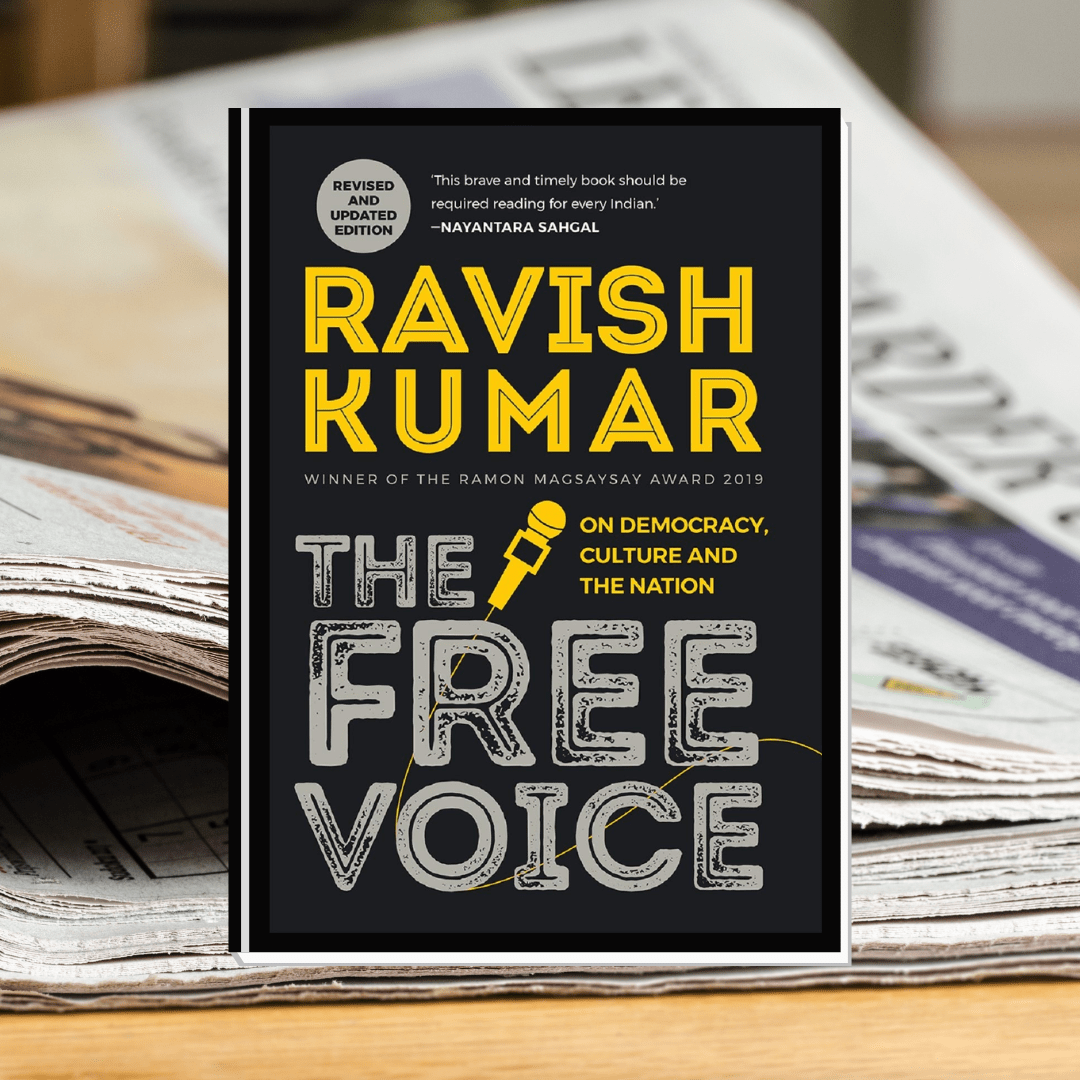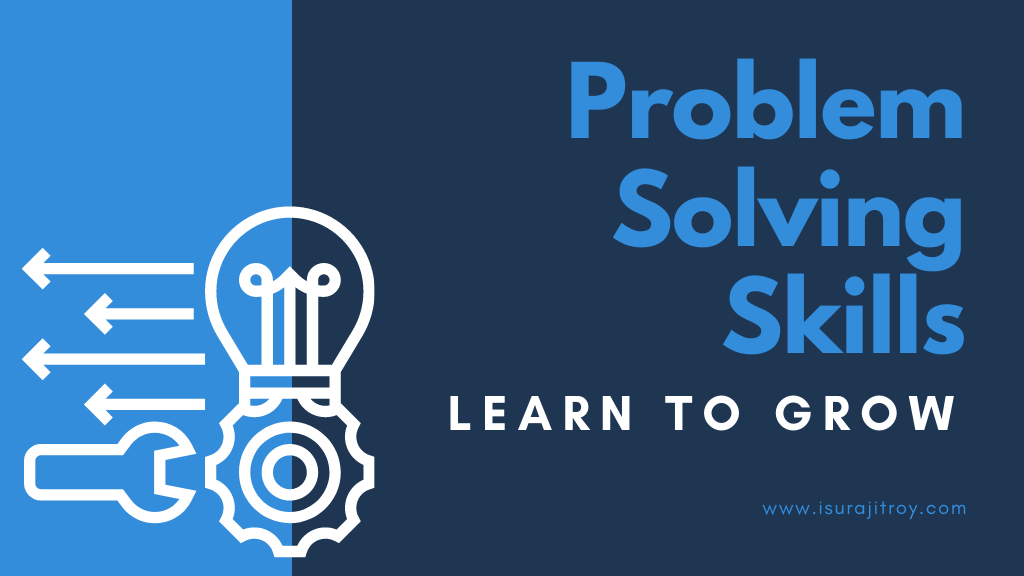
“Unlock Your Problem-Solving Potential – Enhance Your Life and Career Through Creative Solutions!”
Surajit Roy
Problem solving skills are an essential part of life and career. It’s important to be able to think critically and come up with creative solutions to everyday problems. By honing these skills, you can develop a better understanding of the world around you, gain an edge over competitors, and achieve greater success in both your personal and professional life. In this blog, we’ll look at how to develop effective problem solving skills, learn how to grow with them, and explore how they can help you in life and career. So, let’s get started!
What is problem solving skills? – Definition
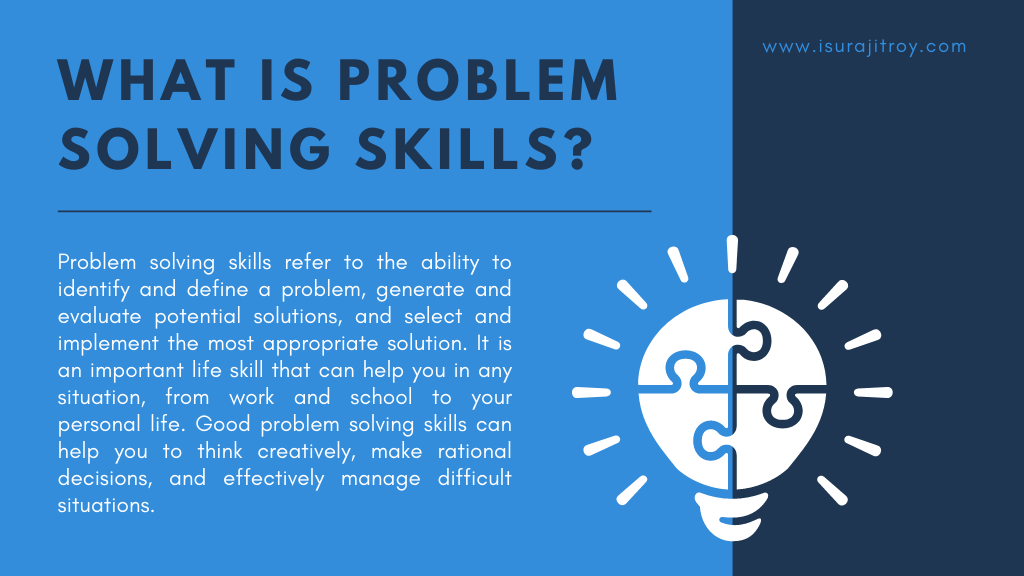
Problem solving skills refer to the ability to identify and resolve problems efficiently and effectively. It involves a systematic approach to solving a problem by breaking it down into smaller components, gathering information, analyzing the issue, developing solutions, and deciding on a course of action.
Problem solving skills are essential for individuals to be successful in life, as they can be applied to any situation or scenario. Problem solving skills involve creative thinking, critical thinking, decision making, and problem solving. Creative thinking helps identify potential solutions, while critical thinking helps analyze the potential solutions.
Decision making involves selecting the best solution from those identified, and problem solving requires taking the necessary steps to implement the chosen solution. Problem solving skills are important in almost every aspect of life, from the workplace to personal relationships.
Road map of problem solving skills.
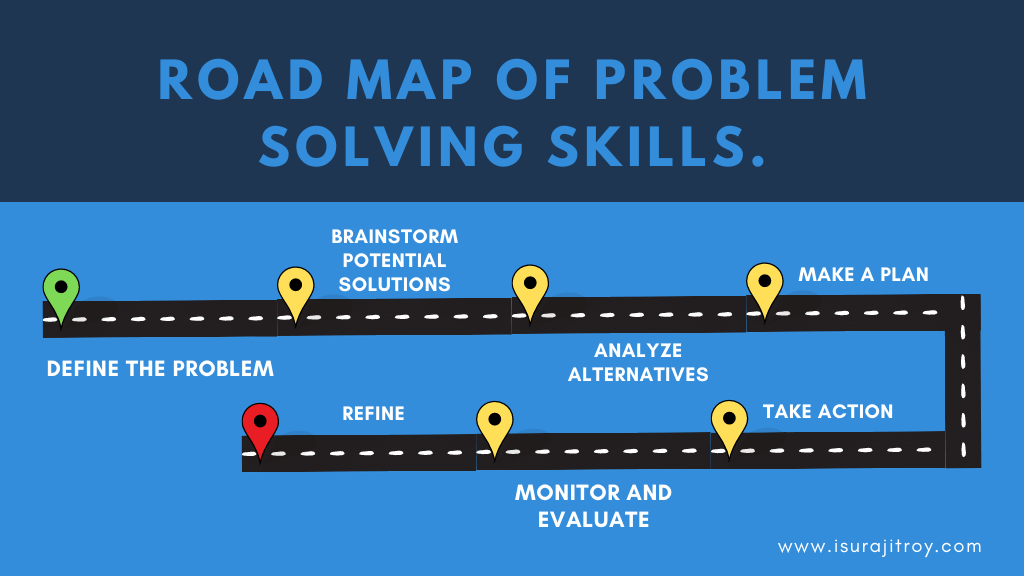
1. Define the Problem
“Clearly articulate the problem and understand the objectives and desired outcomes.”
Clearly articulating the problem is an important step in understanding the objectives and desired outcomes. It involves breaking down the problem into smaller, more manageable sections and understanding the root cause of the problem. Having a clear understanding of the problem allows for more effective problem solving, as it helps to identify the main issues and determine the best course of action. Additionally, understanding the objectives and desired outcomes helps to ensure that the problem is solved in a way that is beneficial for all stakeholders. Knowing the desired outcome helps to guide the problem solving process, allowing for efficient and effective solutions.
2. Brainstorm Potential Solutions
“Generate ideas to solve the problem.”
Generating ideas to solve a problem can be a difficult and time consuming task. It is important to remember that the key to successful problem solving is to think outside the box. Brainstorming is one way to come up with ideas; this could include talking with people, researching online, or even writing down all potential solutions. Additionally, it is important to consider the goals of the problem solving process and to look at the issue from different perspectives. Taking the time to fully understand the problem can help you to come up with creative solutions. Finally, it is important to evaluate each idea and decide which solution best fits the needs of the problem.
3. Analyze Alternatives
“Assess potential solutions and identify the best one.”
Assessing potential solutions is an important part of problem solving. It involves identifying the problem, researching and exploring possible solutions, weighing the pros and cons of each solution, and ultimately selecting the best one. When assessing potential solutions, it is important to consider the costs and benefits of each, the resources needed to implement them, and the potential impact on stakeholders. Additionally, it is important to recognize the risks associated with each solution and how they can be mitigated. Once all of the potential solutions have been considered, it is important to select the one that best meets the needs of the situation and is most likely to solve the problem.
4. Make a Plan
“Create a detailed plan for how to implement the chosen solution.”
When creating a detailed plan for how to implement a chosen solution, it is important to consider the goals of the solution and the resources available. The plan should take into account the timeline for implementation, the steps necessary to reach the goals, the resources necessary to carry out the plan, and any potential risks that could arise. It is also important to have a clear communication plan for all stakeholders involved so that everyone is kept up to date on the progress of the solution. Finally, a plan should also account for any potential changes that may need to be made if the initial solution does not work out as expected. By taking all of these different elements into consideration, a detailed plan can be created that can be used to successfully implement the desired solution.
5. Take Action
“Execute the plan, measure results, and adjust as necessary.”
Executing the plan is essential for achieving success. It is important to measure and monitor the results to ensure that the plan is being implemented to reach the desired goals. If the results are not satisfactory, adjustments should be made to the plan to ensure that the desired goals and objectives are being met. This can involve making changes to the plan, such as altering the timeline or resources, or including additional elements. The adjustments must be carefully considered to ensure that they are appropriate and have a positive effect on the outcome. Regular reviews of the plan and results should be conducted to ensure that the plan is being implemented effectively and achieving the desired results.
6. Monitor and Evaluate
“Monitor progress and evaluate the success of the solution.”
Monitoring progress and evaluating the success of a solution is an important step in the problem-solving process. This involves measuring the progress of the solution to ensure it is achieving the desired result. This can be done through collecting data, conducting surveys, and observing changes in the environment. Evaluation of a solution involves analyzing the collected data to determine if the solution is meeting its objectives. This can include measuring if the solution is producing the desired outcomes and determining if any changes need to be made. It is also important to consider if the solution is sustainable and cost-effective. Monitoring progress and evaluation are essential components of the problem-solving process and should be done regularly to ensure the success of the solution.
7. Refine
“Make improvements and adjustments to the solution.”
Making improvements and adjustments to the solution is an important part of the problem-solving process. This involves testing the solution to determine if it is meeting the desired objectives, identifying areas where the solution could be improved, and then making changes to the solution to make it better. This could include introducing new technology, making design changes, or even rethinking the entire process. The key is to ensure that any changes made are based on data and feedback from users and stakeholders, rather than simply making changes for the sake of making changes.
What is decision making? – Definition
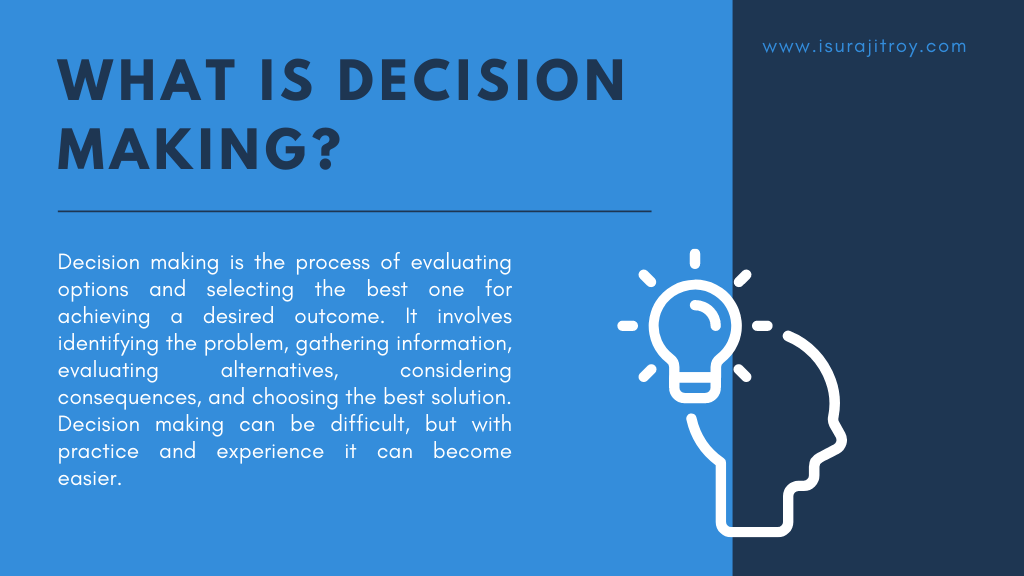
Decision making is the process of identifying and choosing among alternative courses of action in order to achieve a desired outcome. Decision making can be regarded as a problem-solving activity, and is commonly identified as one of the core functions of management.
To make sound decisions, decision makers must be able to identify and analyze potential courses of action, evaluate potential outcomes, and select the best option based on specific criteria. Decision making is a complex process that involves a number of factors, including the availability of information, the complexity of the problem, the urgency of the situation, the individual characteristics of the decision maker, the organizational context, and the presence of external influences.
Decision makers must also factor in their own values and beliefs when making decisions, as these can affect the outcome. In addition, decision makers must be aware of the potential consequences of their decisions, and must be willing to take responsibility for their choices.
How does problem solving skills relate to decision-making?
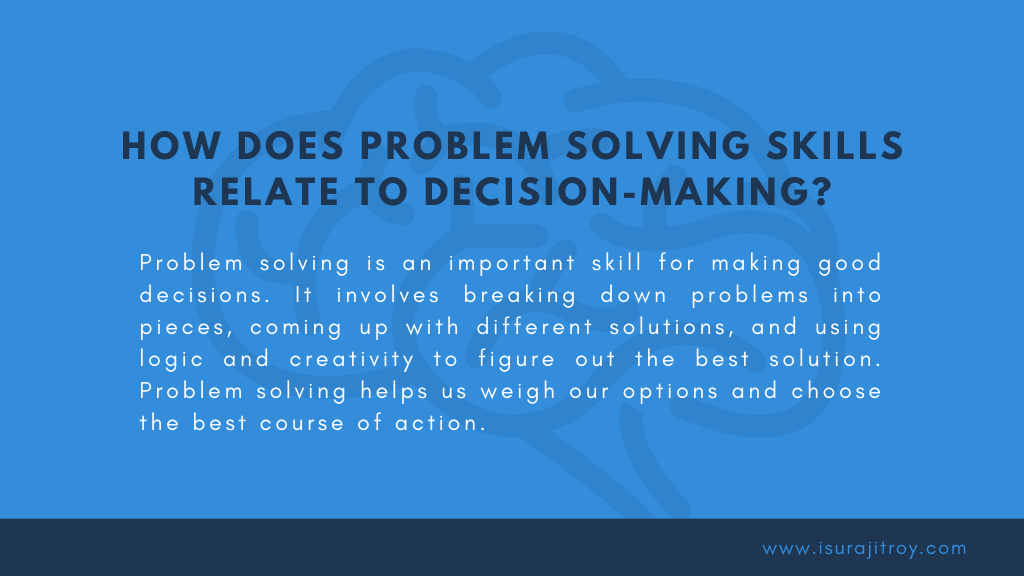
Problem solving skills are essential for making effective decisions. Problem solving involves identifying the problem, gathering relevant information, analyzing the data and developing possible solutions. This process requires the ability to think critically and logically, analyze data, and make informed decisions.
Making decisions requires the ability to weigh different options and determine the best one. Problem solving is the process of gathering information, analyzing it and then evaluating it to come up with a solution to a given problem. This process requires problem-solving skills, such as being able to identify the problem, evaluate the data, think logically, and develop potential solutions.
When making decisions, problem solving skills are crucial for identifying the problem, gathering relevant information, analyzing the data, and coming up with a solution. Problem solving skills help decision makers determine the best course of action by weighing the pros and cons of each option available. By using problem solving skills, decision makers can make the most informed and effective decisions.
Problem solving skills also help decision makers think through potential consequences of their decisions. By being aware of potential pitfalls and considering potential solutions, decision makers can make more informed decisions. This ensures that decisions are made with greater insight and accuracy, leading to better outcomes.
Be aware before making a decision.
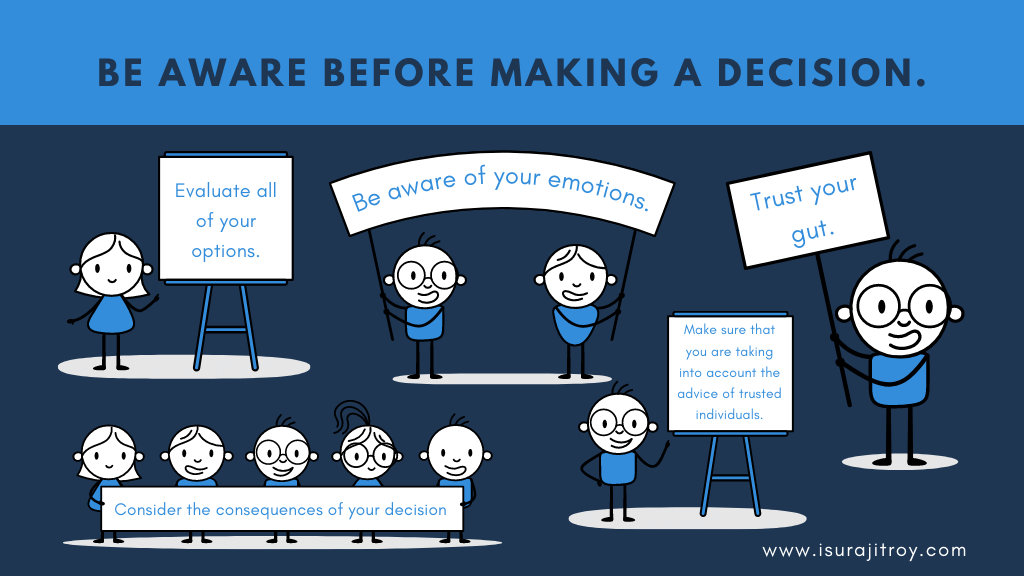
Making decisions can be difficult, especially if there are important consequences involved. Before making a decision, it is important to be aware of a few things.
First, evaluate all of your options. Take the time to consider every possibility and make sure to weigh the pros and cons of each option. This will help to ensure that you make an informed decision.
Second, consider the consequences of your decision. Think about how it will affect you, as well as those around you. It is important to consider the long-term implications of your decision, as well as any potential risks.
Third, be aware of your emotions. Decisions made in the heat of the moment can often lead to regret. Take the time to think things through and make sure to consider your feelings before making a decision.
Fourth, make sure that you are taking into account the advice of trusted individuals. Having a second opinion can be invaluable and can help to prevent you from making a decision that you may later regret.
Finally, trust your gut. You know yourself and your situation better than anyone else, so make sure to listen to your inner voice when making a decision.
By following these tips, you can ensure that you make the best decision possible. Remember to be aware before making a decision and trust your judgment.
How to take right decision when confused?
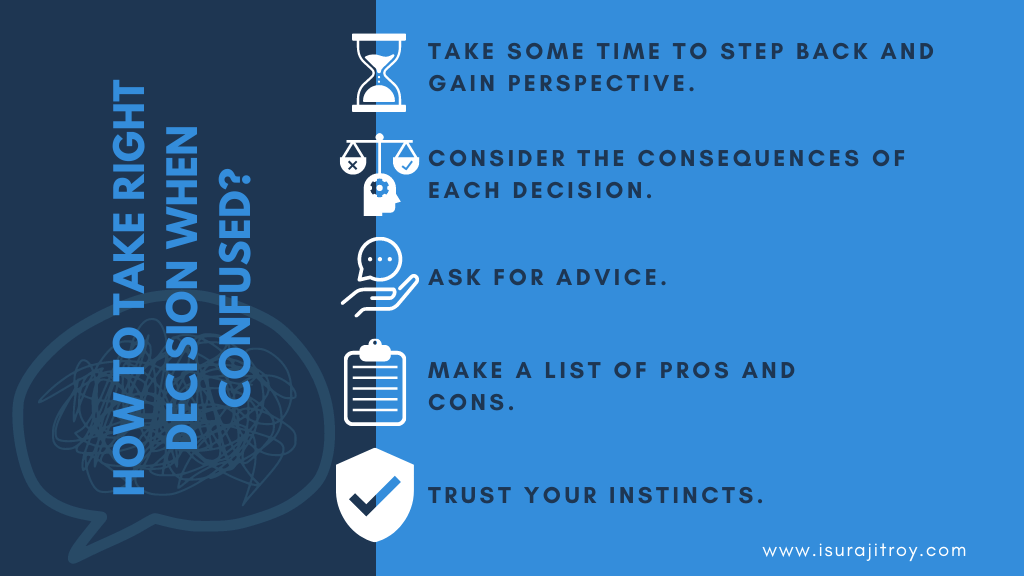
When you are feeling confused about which decision to make, it is important to take some time to think through the situation and evaluate your choices.
First, take some time to step back and gain perspective. When we’re overwhelmed by a decision, it is easy to feel like we’re stuck and unable to think clearly. Taking a step back and reflecting on the situation can help to give you a more objective view of the situation and allow you to consider more options.
Second, consider the consequences of each decision. Think through the potential outcomes of making each decision, and consider the short-term and long-term implications. This will help you to weigh up the pros and cons of each decision, and make a more informed choice.
Third, ask for advice. Talk to people you trust, such as family and friends, or seek out professionals with expertise in the issue. These people can provide helpful insights and advice, which could help you to make a more informed decision.
Fourth, make a list of pros and cons. Writing down the advantages and disadvantages of each decision can help to make the decision-making process more organized and logical.
Finally, trust your instincts. Make sure that you consider all of the information available to you, but ultimately trust your gut instincts. This is especially important if the decision is an emotional one.
In conclusion, while making decisions can be difficult, taking the time to consider your options and think through the situation can help you to take the right decision even when you are feeling confused.
Conclusion
We all have the potential to use problem-solving skills and decision-making to grow in life and career. Learning to assess a situation, think through the possible solutions, and make an informed decision is a valuable ability to have. As with any skill, practice makes perfect. The more you use your problem-solving and decision-making skills, the better you’ll become at them. As you continue to hone these skills, you’ll be able to face challenges head-on and make better decisions for your life and career.

